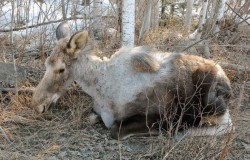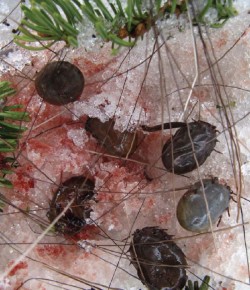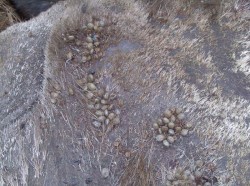
The tracks and splattered blood stains in the snow told the story. Hours before, a cow moose trotted through the deep late-March snowpack and, where she passed, drops of blood, patches of hair covered with tick feces, and dislodged ticks revealed that she was host to thousands of winter ticks, Dermacentor albipictus. Moose with heavy infestations of these parasites are miserable by March and must feel as wretched as they look. Our cow might be described by rural Canadians as a “ghost moose,” because the cumulative effects of her compulsive grooming have ruined her dark winter guard hairs, exposing an unkempt, whitish stubble of broken hair shafts next to the skin. Were we to actually see the moose’s tormentors, we might observe the shingled attachment of as many as 30 ticks per square inch of flesh. Moose that are afflicted with this many ticks will lose 40 to 100 percent of their insulating hair by April, a condition which may lead to death by hypothermia.
According to winter tick authority Dr. Bill Samuel, professor emeritus, University of Alberta, hypothermia is not the only problem associated with winter ticks. Compulsive licking, scratching, and rubbing robs a moose of time that is better spent feeding and resting. In early spring, such a moose is in serious trouble, because this behavior bankrupts the animal’s already meager energy budget at a time when food quality is poor and fat reserves are low.
In areas where the moose has nonhuman predators, vulnerability to wolves and cougars increases as a moose becomes preoccupied with grooming. Heavy tick loads can also lead to chronic anemia, especially in calves. Samuel and his colleagues estimated that a calf infested with 30,000 ticks must replace 57.9 percent of its blood volume in March and April. University of New Hampshire researcher Anthony Musante and colleagues calculated that infestations involving 70,000 ticks may result in the need to replace 112 percent of the animal’s blood volume during the same timeframe.
Winter ticks are arthropods that live on members of the deer family. Their life cycle begins in the spring, when a blood-engorged female disengages from a moose and falls to the ground, where she lays her eggs. Thousands upon thousands of salt-grain-sized larvae, called seed ticks, hatch from these eggs.
So how does a seed tick the size of a pinhead get a leg up on a six-foot-tall moose? In late summer and early autumn, the larvae ascend vegetation, find a spot that’s about torso height, then wait and hope to ambush a moose host. The questing larval clumps sense the approach of a host in several ways, including the detection of carbon dioxide from a moose’s breath from as much as 50 feet away and the shade and vibrations created by the passing animal. Amazingly, larval clumps are made up of multiple ticks whose legs are interlocked, which guarantees that the attaching ticks will pull a “chain” of companions onto the moose.
Questing continues well into autumn, depending on the severity of tick-killing frosts and snowfall. By October and November, attached larvae are feeding and beginning to molt into nymphs, which in turn feed and molt into adult ticks. By February, adult ticks are mating and feeding upon moose blood en masse. Peanut-sized adult female tick bodies are swollen with blood and reddishbrown or shiny gray in color. These ticks engorge themselves with blood in preparation for their departure from moose in March and April.
Moose die-offs from winter ticks and other parasites are increasing, from Wyoming to Minnesota, Alberta to Manitoba, though the ticks by themselves aren’t solely to blame. Winter ticks are a native parasite, so they’ve been coexisting with moose for thousands of years. As per the unspoken rule between parasite and host, the ticks shouldn’t be fatal. And it’s possible for a moose to live a long, healthy life, despite heavy winter tick infestations in the winter months.
Vermont’s moose biologist, Cedric Alexander, reminds us that in the northeast, “high tick outbreaks have been most common when moose densities were at high levels, and high host densities facilitate a greater transmission and prevalence of parasites.” In other words, if moose populations become excessive, winter tick populations may become excessive. Overpopulation leads to overbrowsing, which leads to reduced nutrition, and a malnourished moose is more likely to succumb to parasites and disease.
Moose biologist Lee Kantar suspects that periodic heavy winter-tick-caused mortality in Maine may be the result of a deadly one-two punch of winter tick and lungworm – a nematode that causes bronchitus and lung lesions. “The winter tick/lungworm dynamic is one that Maine Inland Fisheries and Wildlife is acutely aware of and concerned with,” said Kantar.
Biologists also worry that the perturbations of climate change are affecting moose fitness and vulnerability worldwide. Hotter summers and warmer autumn and spring weather, coupled with shorter winters and reduction of freezing weather (which constrains tick survival and transmission), combine to both stress this iconic mammal and favor its parasites.
“Moose face a triple threat in our changing climate,” said New Hampshire moose biologist Kristen Rines. “Increasing temperatures, changing forest species, and increased mortality due to parasites may make it very hard to maintain a viable moose population in New Hampshire in the future.”
Will our well-watered landscape, boreal forests, and mountainous terrain allow moose to cope adequately with increasing temperatures? Only time will tell.






Discussion *